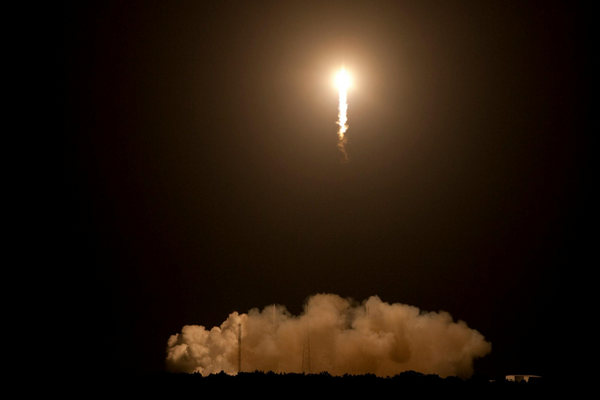The volcanic fissure that opened up in Iceland early Wednesday has now expanded, and stretches further north than at any time since 2023.
Lava and toxic gas continue to spill from the latest eruption on the Reykjanes Peninsula.
Officials say the crack in the ground measures some 2.4 kilometres, with fresh lava now covering 3.2 square kilometres.
A large sulfur dioxide gas cloud is blowing toward Keflavík International Airport. Authorities have told people nearby to stay indoors and keep their windows shut as pollution levels rise. Despite this, flights are running normally and the airport remains open.
Nearby towns, the popular Blue Lagoon spa, and other tourist sites were evacuated as a safety measure. Grindavík, a town evacuated last year, remains largely empty.
This marks the twelfth eruption in the area since 2021 and is part of a growing sequence of volcanic events on the Reykjanes Peninsula, which began when dormant systems were reactivated after centuries of silence.
Key Points
- Lava flow continues on second day but has decreased in intensity, says IMO
- Iceland volcano erupts opening up 1km-long fissure
- Gas cloud spreading north from volcano towards Keflavik
- Blue Lagoon evacuated as Sundhnúkur erupts
- Air travel remains normal following Iceland volcano eruption
Full story: Iceland volcano erupts opening up 1km-long fissure
10:40 , Steffie BanatvalaA volcano on Iceland’s Reykjanes Peninsula erupted again on Wednesday, spewing lava and smoke in what officials say is the twelfth eruption in the region since 2021.
The eruption prompted fresh evacuations from the nearby town of Grindavík, a luxury hotel, and the popular Blue Lagoon spa, Icelandic authorities said.
The Icelandic Meteorological Office (IMO) said magma pushed through the earth’s crust, opening a fissure estimated to be between 700 and 1,000 metres long.
Read more:
Tourists evacuated as Iceland volcano erupts opening up 1km-long fissure
Video: Tourists evacuated after Iceland’s Reykjanes Peninsula hit by 12th eruption in four years
10:10 , Steffie BanatvalaMapped: Iceland eruption
09:40 , Steffie BanatvalaThis is the 12th eruption in the region since 2021
09:10 , Steffie BanatvalaThe latest eruption is part of a broader pattern of seismic activity that reawakened the Reykjanes Peninsula in 2021 after centuries of dormancy. Since then, the area has seen repeated volcanic events, with fissure eruptions now becoming a near-annual phenomenon.
Experts say Iceland is now in a new volcanic cycle, with magma expected to keep surfacing in the region for years or even decades.

If you're just joining us: Iceland volcano re-capped
08:42 , Steffie Banatvala- Yesterday an Iceland volcano erupted and the volcanic fissure expanded today - the furthest north its been since 2023 .
- Authorities decided to evacuate the nearby town, with police saying it went smoothly.
- The Reykjanes peninsula has faced a string of volcanic eruptions since 2021 when geological systems dormant for 800 years re-activated.
Lava flow continues but has decreased in intensity, says IMO
07:56 , Stuti MishraIceland’s Sundhnúkur crater continued this morning, though officials say there is a slowdown in both lava flows and earthquakes.
The Icelandic Meteorological Office (IMO) said the main fissure, which opened northeast of Stóra Skógfell early yesterday, has elongated and now extends further north than any since late 2023.
Lava is mostly accumulating to the east, spreading across low-lying areas and covering about 3.2 square kilometres according to the latest satellite imagery.
Volcanic tremor and seismic activity have dropped significantly since the initial outburst, with only a few minor quakes recorded per hour.
"The eruption is ongoing, but intensity has declined since this morning," the IMO said in its latest update.
However, hazardous gases and wildfires remain a serious risk for communities on the Reykjanes Peninsula, it said.
High concentrations of sulfur dioxide are being measured over the region, extending westward on strong southeast winds. Residents in towns including Reykjanesbær, Vogar and Sandgerði were warned to keep windows closed, turn off ventilation, and stay indoors during high pollution periods.
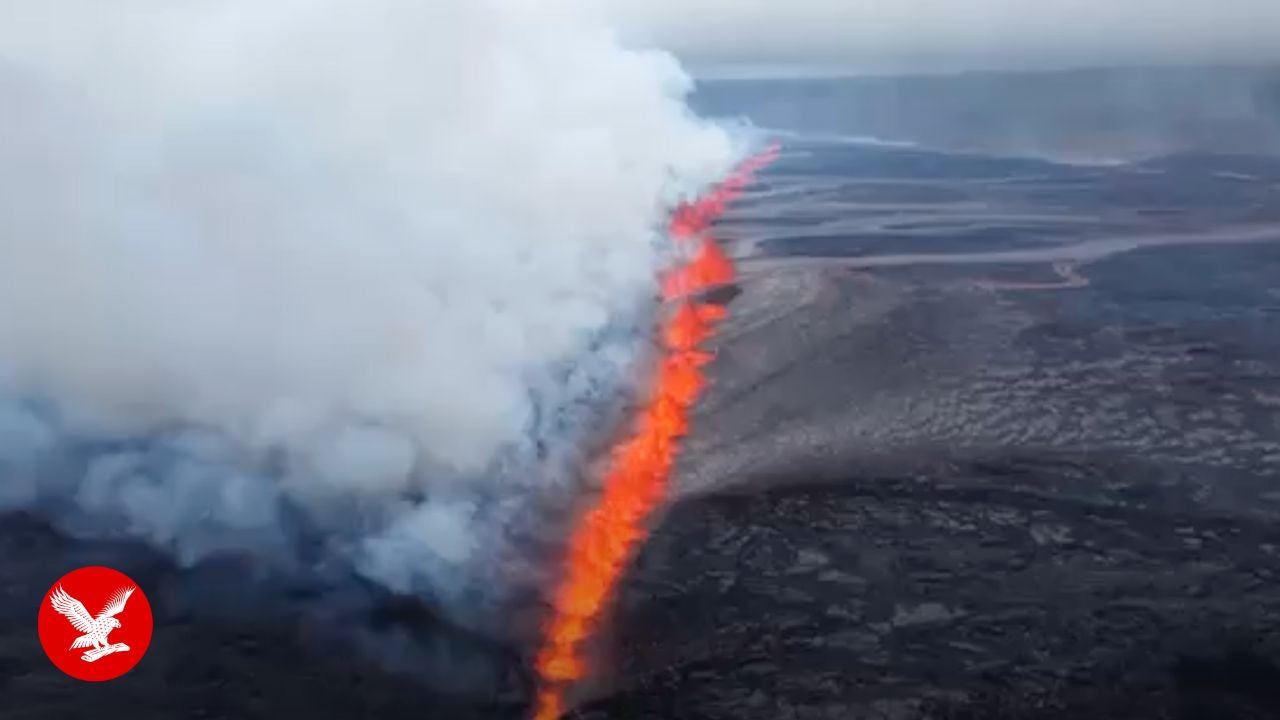
Lava flows from wall of fire during volcanic eruption in Iceland
07:46 , Stuti Mishra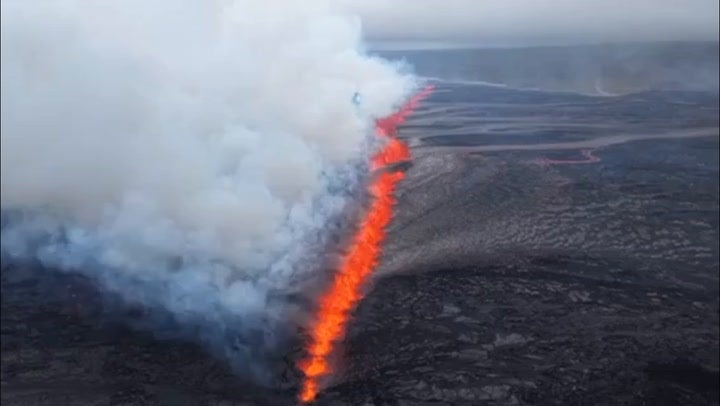
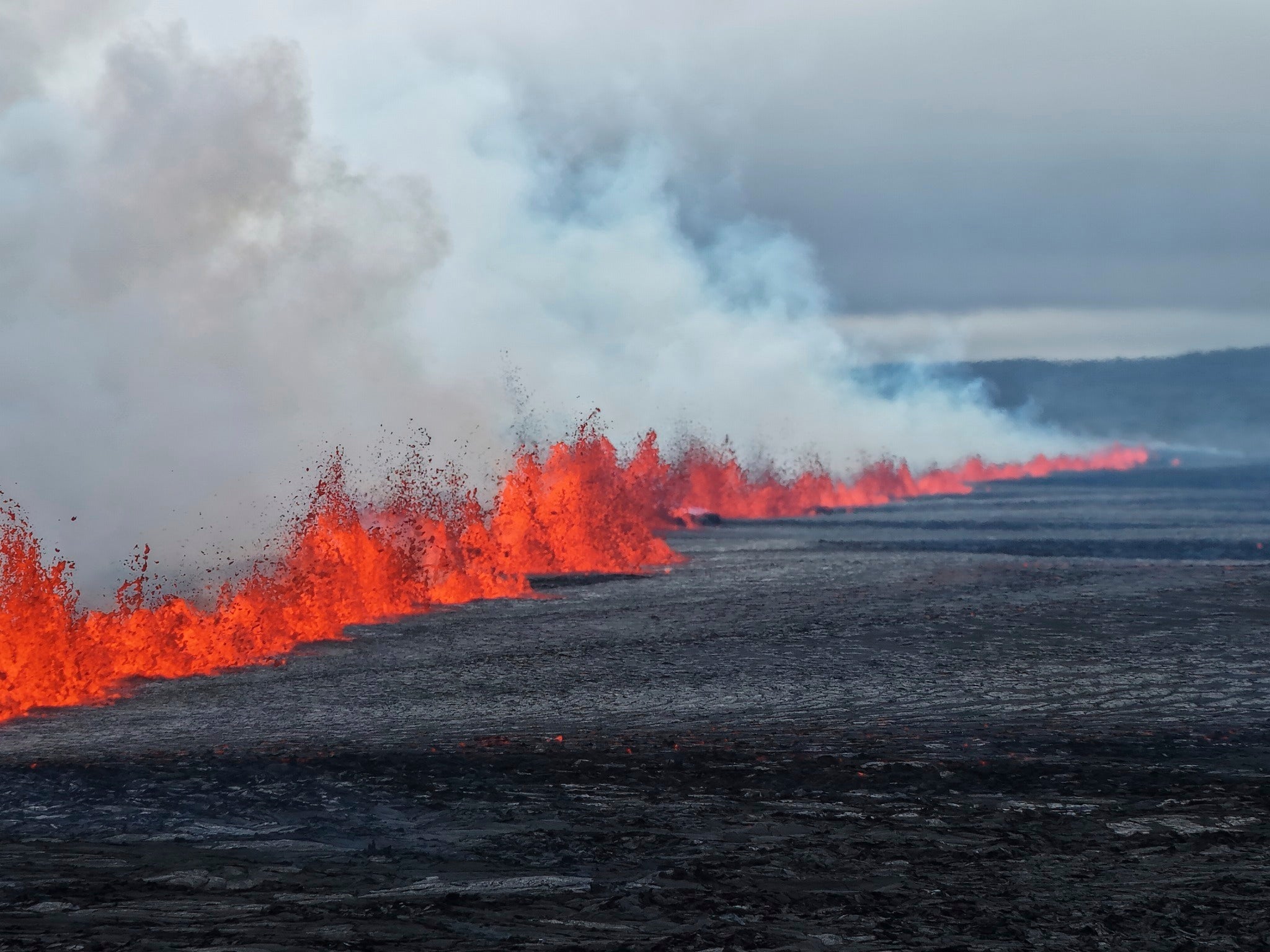
Evacuation went smoothly, police say
07:12 , Stuti MishraPolice commissioner Margret Palsdottir told AP the evacuation went smoothly and lasted about 90 minutes.
“Of course, people have different opinions on whether the evacuation is necessary, but it is a decision we make and take responsibility for,” she said.
Recent eruptions in Iceland
03:00 , Alexander ButlerToday’s eruption near Sundhnúkur crater is the 12th since volcanic activity reawakened on the Reykjanes Peninsula in 2021, ending nearly 800 years of geological silence in the region.Here’s a quick look at the most recent eruptions in the same system:
- Dec 2023: A powerful fissure eruption near Hagafell led to the first full evacuation of Grindavík and triggered widespread ground deformation.
- Jan 2024: Lava breached defences, destroying homes and killing one person in a ground collapse.
- Feb 2024: A short but intense eruption cut off hot-water pipelines, causing major disruption in the region.
- Mar–May 2024: The longest and most voluminous eruption so far, lasting 54 days and producing 35 million cubic metres of lava.
- May–June 2024: Another eruption followed, keeping the region under continuous alert.
- Nov–Dec 2024: Lava reached the Blue Lagoon car park during a fissure event, prompting mass evacuations once again.
Evacuations ordered in Grindavík
Thursday 17 July 2025 00:01 , Alexander ButlerThe eruption prompted fresh evacuations from the nearby town of Grindavík. However, the town has been almost empty for months.
Authorities first ordered a full evacuation of the town in November 2023 after seismic activity and land deformation signalled a high risk of magma movement beneath the area.
A fissure eruption in December caused structural damage to roads and buildings. Subsequent eruptions in January and February 2024 led to further destruction, including the collapse of homes and the death of one person due to ground cracking.
Although some residents briefly returned during calmer periods, the area has remained largely off-limits.
This is what we know so far about the Sundhnúkur eruption in Iceland
Wednesday 16 July 2025 21:00 , Alexander Butler- A volcanic eruption began early on Wednesday near Sundhnúkur crater on the Reykjanes Peninsula, southwest Iceland.
- Lava is flowing from a fissure estimated to be 700–1,000 metres long, according to the Icelandic Meteorological Office (IMO).
- Authorities evacuated Grindavík, the nearby Blue Lagoon resort, and surrounding areas as a safety measure.
- No infrastructure has been damaged so far, and there is currently no threat to populated areas.
- The eruption has not affected flights at Keflavík International Airport, operations are continuing as normal.
- This marks the 12th eruption in the Reykjanes region since 2021, part of a prolonged volcanic cycle.
- Experts warn that similar eruptions may continue in the region over the coming months or years.
This is the 12th eruption in the region since 2021
Wednesday 16 July 2025 20:00 , Alexander ButlerThe latest eruption is part of a broader pattern of seismic activity that reawakened the Reykjanes Peninsula in 2021 after centuries of dormancy. Since then, the area has seen repeated volcanic events, with fissure eruptions now becoming a near-annual phenomenon.
Experts say Iceland is now in a new volcanic cycle, with magma expected to keep surfacing in the region for years or even decades.
Current eruption is relatively small, officials say
Wednesday 16 July 2025 19:00 , Alexander ButlerIceland’s latest volcanic eruption on the Reykjanes Peninsula is not considered a major event, according to the Icelandic Meteorological Office.
The fissure, located near Sundhnúkur crater, measures about 700 to 1,000 metres long, but officials say the eruption is relatively small, with lava flowing steadily to the southeast, away from critical infrastructure.
“There is no immediate threat to populated areas or key services,” the IMO said, adding that deformation data and GPS readings suggest limited magma output.
Civil defence authorities have evacuated surrounding areas as a precaution, but most of the disruption is localised.
Unlike explosive eruptions that produce large ash plumes, this is a low-ash fissure eruption, meaning it’s unlikely to affect air travel or trigger widespread fallout.
Similar eruptions have occurred on the peninsula repeatedly since 2021 as part of a longer volcanic cycle.
Air travel remains normal following Iceland volcano eruption
Wednesday 16 July 2025 18:00 , Alexander ButlerFlights at Reykjavík’s Keflavík International Airport are unaffected following the volcano eruption.
Flight radar and airport communications show no cancellations or diversions, and airlines including Icelandair, easyJet, and PLAY are operating as scheduled. The eruption does not project ash into the stratosphere, so international routes remain clear, officials say.
Despite ongoing lava flows near Grindavík, experts say this eruption's low-ash nature means it’s unlike the previous disruptive events which have grounded flights.
Iceland volcano erupts opening up 1km-long fissure
Wednesday 16 July 2025 17:00 , Alexander ButlerA volcano on Iceland’s Reykjanes Peninsula erupted again on Wednesday, spewing lava and smoke in what officials say is the twelfth eruption in the region since 2021.
The eruption prompted fresh evacuations from the nearby town of Grindavík, a luxury hotel, and the popular Blue Lagoon spa, Icelandicauthorities said.
The Icelandic Meteorological Office (IMO) said magma pushed through the earth’s crust, opening a fissure estimated to be between 700 and 1,000 metres long.
Read more:

Tourists evacuated as Iceland volcano erupts opening up 1km-long fissure
Blue Lagoon evacuated as Sundhnúkur erupts
Wednesday 16 July 2025 17:00 , Alexander ButlerIceland’s Blue Lagoon geothermal spa and nearby Grindavík were evacuated early today after Sundhnúkur volcano reactivated.
Civil defence teams have evacuated hotel guests, campers, and residents as a precaution, officials said.
The Blue Lagoon resort is one of the most luxurious and renowned hotels in the region, famous for its geothermal spa.
The eruption came from a 700–1,000 m fissure on the Reykjanes Peninsula.
Officials have described this as a small disruption as lava flows southeast, away from key infrastructure. However, this marks the 12th eruption in the region since 2021, part of a prolonged volcanic cycle that could last decades.
Recent eruptions in Iceland
Wednesday 16 July 2025 16:00 , Alexander ButlerToday’s eruption near Sundhnúkur crater is the 12th since volcanic activity reawakened on the Reykjanes Peninsula in 2021, ending nearly 800 years of geological silence in the region.Here’s a quick look at the most recent eruptions in the same system:
- Dec 2023: A powerful fissure eruption near Hagafell led to the first full evacuation of Grindavík and triggered widespread ground deformation.
- Jan 2024: Lava breached defences, destroying homes and killing one person in a ground collapse.
- Feb 2024: A short but intense eruption cut off hot-water pipelines, causing major disruption in the region.
- Mar–May 2024: The longest and most voluminous eruption so far, lasting 54 days and producing 35 million cubic metres of lava.
- May–June 2024: Another eruption followed, keeping the region under continuous alert.
- Nov–Dec 2024: Lava reached the Blue Lagoon car park during a fissure event, prompting mass evacuations once again.
Current eruption is relatively small, officials say
Wednesday 16 July 2025 15:45 , Alexander ButlerIceland’s latest volcanic eruption on the Reykjanes Peninsula is not considered a major event, according to the Icelandic Meteorological Office.
The fissure, located near Sundhnúkur crater, measures about 700 to 1,000 metres long, but officials say the eruption is relatively small, with lava flowing steadily to the southeast, away from critical infrastructure.
“There is no immediate threat to populated areas or key services,” the IMO said, adding that deformation data and GPS readings suggest limited magma output.
Civil defence authorities have evacuated surrounding areas as a precaution, but most of the disruption is localised.
Unlike explosive eruptions that produce large ash plumes, this is a low-ash fissure eruption, meaning it’s unlikely to affect air travel or trigger widespread fallout.
Similar eruptions have occurred on the peninsula repeatedly since 2021 as part of a longer volcanic cycle.
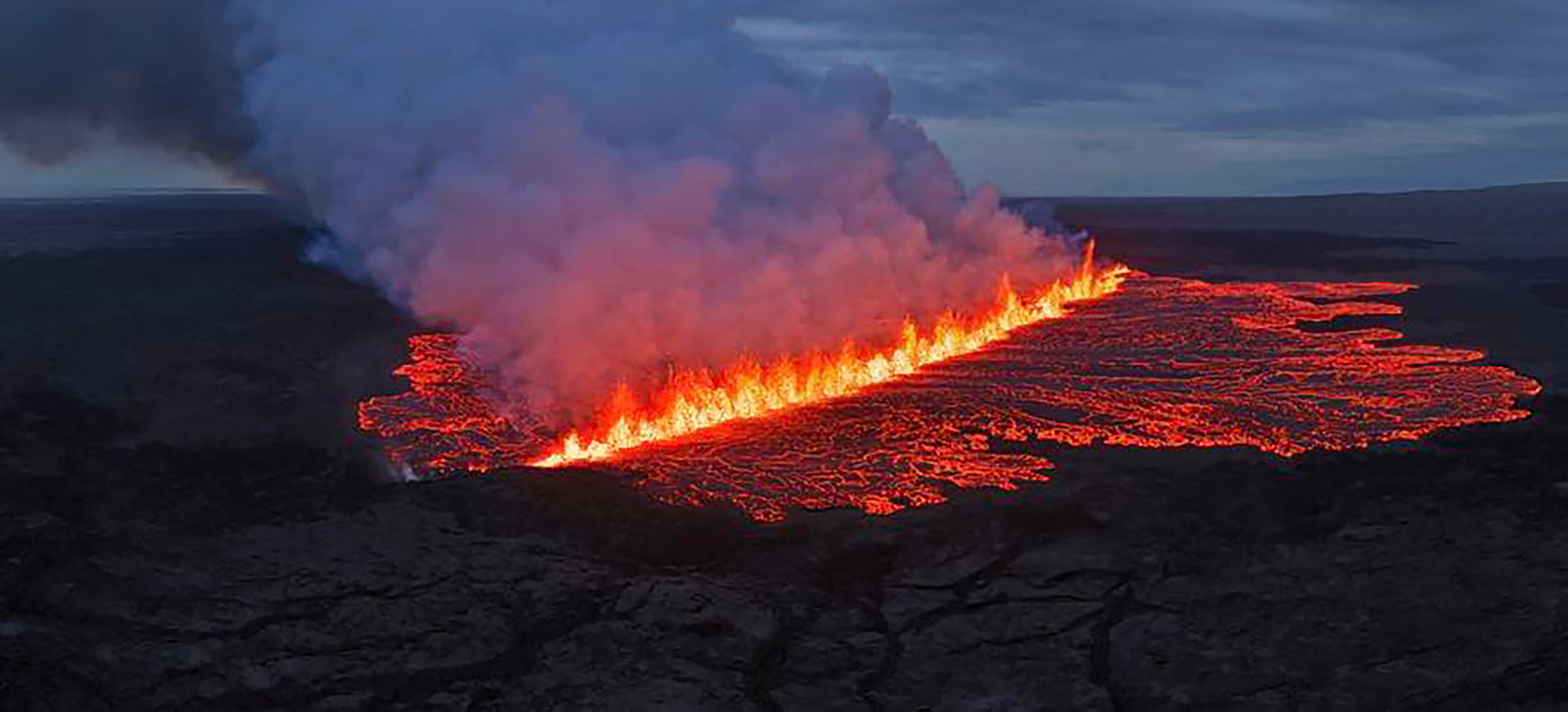
Recap: Blue Lagoon evacuated as Sundhnúkur erupts
Wednesday 16 July 2025 15:30 , Alexander ButlerIceland’s Blue Lagoon geothermal spa and nearby Grindavík were evacuated early today after Sundhnúkur volcano reactivated.
Civil defence teams have evacuated hotel guests, campers, and residents as a precaution, officials said.
The Blue Lagoon resort is one of the most luxurious and renowned hotels in the region, famous for its geothermal spa.
The eruption came from a 700–1,000 m fissure on the Reykjanes Peninsula.
Officials have described this as a small disruption as lava flows southeast, away from key infrastructure. However, this marks the 12th eruption in the region since 2021, part of a prolonged volcanic cycle that could last decades.
Iceland volcano erupts opening up 1km-long fissure
Wednesday 16 July 2025 15:15 , Alexander ButlerA volcano on Iceland’s Reykjanes Peninsulaerupted again on Wednesday, spewing lava and smoke in what officials say is the twelfth eruption in the region since 2021.
The eruption prompted fresh evacuations from the nearby town of Grindavík, a luxury hotel, and the popular Blue Lagoon spa, Icelandicauthorities said.
The Icelandic Meteorological Office (IMO) said magma pushed through the earth’s crust, opening a fissure estimated to be between 700 and 1,000 metres long.
Read more:

Tourists evacuated as Iceland volcano erupts opening up 1km-long fissure
This is the 12th eruption in the region since 2021
Wednesday 16 July 2025 15:00 , Stuti MishraThe latest eruption is part of a broader pattern of seismic activity that reawakened the Reykjanes Peninsula in 2021 after centuries of dormancy. Since then, the area has seen repeated volcanic events, with fissure eruptions now becoming a near-annual phenomenon.
Experts say Iceland is now in a new volcanic cycle, with magma expected to keep surfacing in the region for years or even decades.
What makes Iceland so volcanically active?
Wednesday 16 July 2025 14:48 , Alexander ButlerIceland sits directly on the Mid-Atlantic Ridge, where the North American and Eurasian tectonic plates are pulling apart.
This geological hotspot fuels regular volcanic and seismic activity. The Reykjanes Peninsula, now erupting again, had been dormant for 800 years before reawakening in 2021.
Recap: Evacuations ordered in Grindavík
Wednesday 16 July 2025 14:30 , Alexander ButlerThe eruption prompted fresh evacuations from the nearby town of Grindavík. However, the town has been almost empty for months.
Authorities first ordered a full evacuation of the town in November 2023 after seismic activity and land deformation signalled a high risk of magma movement beneath the area.
A fissure eruption in December caused structural damage to roads and buildings. Subsequent eruptions in January and February 2024 led to further destruction, including the collapse of homes and the death of one person due to ground cracking.
Although some residents briefly returned during calmer periods, the area has remained largely off-limits.
This is what we know so far about the Sundhnúkur eruption in Iceland
Wednesday 16 July 2025 14:15 , Stuti Mishra
- A volcanic eruption began early on Wednesday near Sundhnúkur crater on the Reykjanes Peninsula, southwest Iceland.
- Lava is flowing from a fissure estimated to be 700–1,000 metres long, according to the Icelandic Meteorological Office (IMO).
- Authorities evacuated Grindavík, the nearby Blue Lagoon resort, and surrounding areas as a safety measure.
- No infrastructure has been damaged so far, and there is currently no threat to populated areas.
- The eruption has not affected flights at Keflavík International Airport, operations are continuing as normal.
- This marks the 12th eruption in the Reykjanes region since 2021, part of a prolonged volcanic cycle.
- Experts warn that similar eruptions may continue in the region over the coming months or years.
Gas cloud spreading north of volcano and projected to hit airport on Thursday
Wednesday 16 July 2025 13:49 , Adam WithnallImagery from the Icelandic Meteorological Office shows a cloud of sulphur dioxide gas emanating from the volcano is currently being driven north towards the town of Keflavik.
The IMO forecasts that a slight change in wind conditions tomorrow will take the gas cloud directly over Iceland’s main international airport, which is located west of Keflavik.
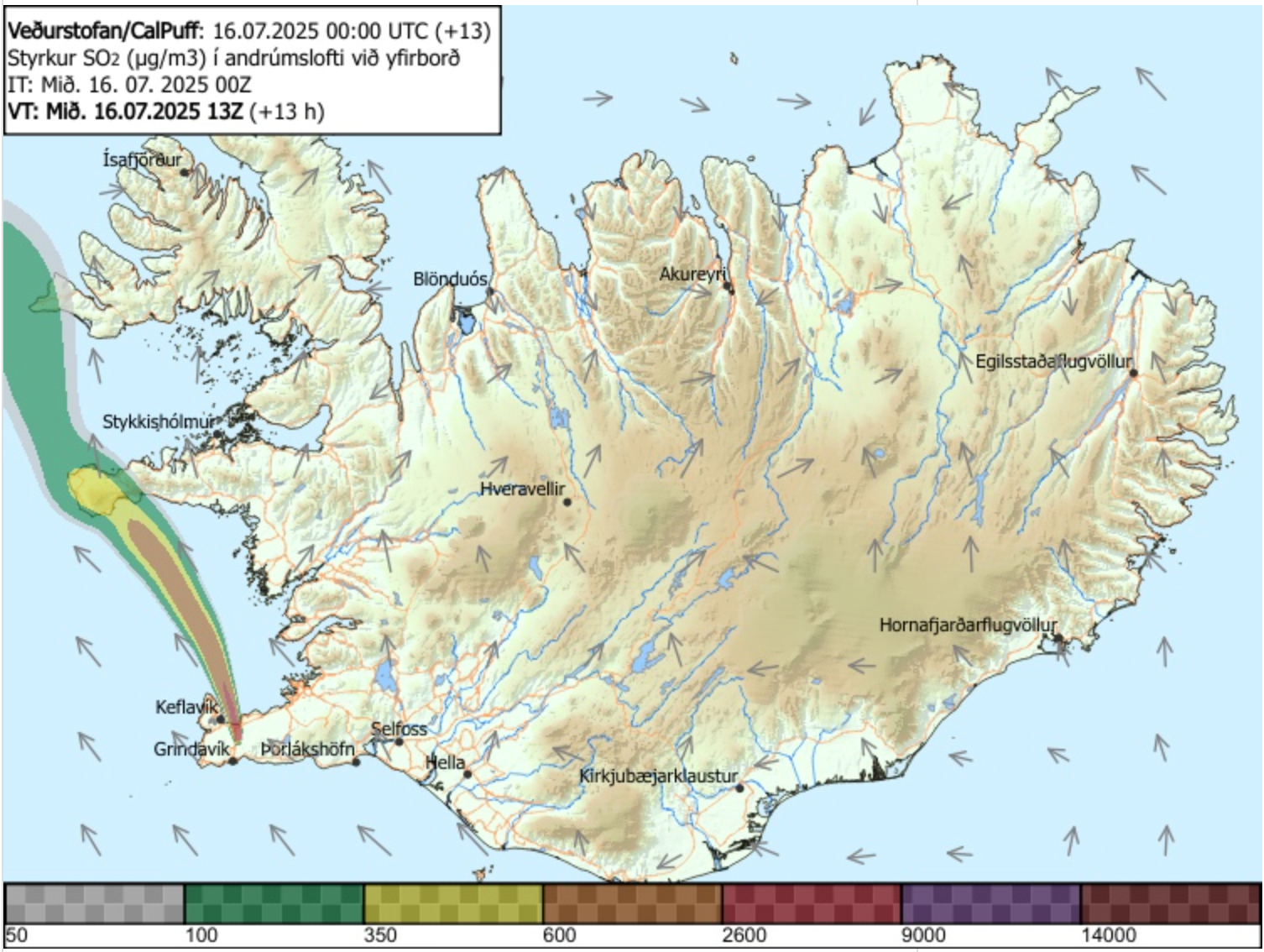
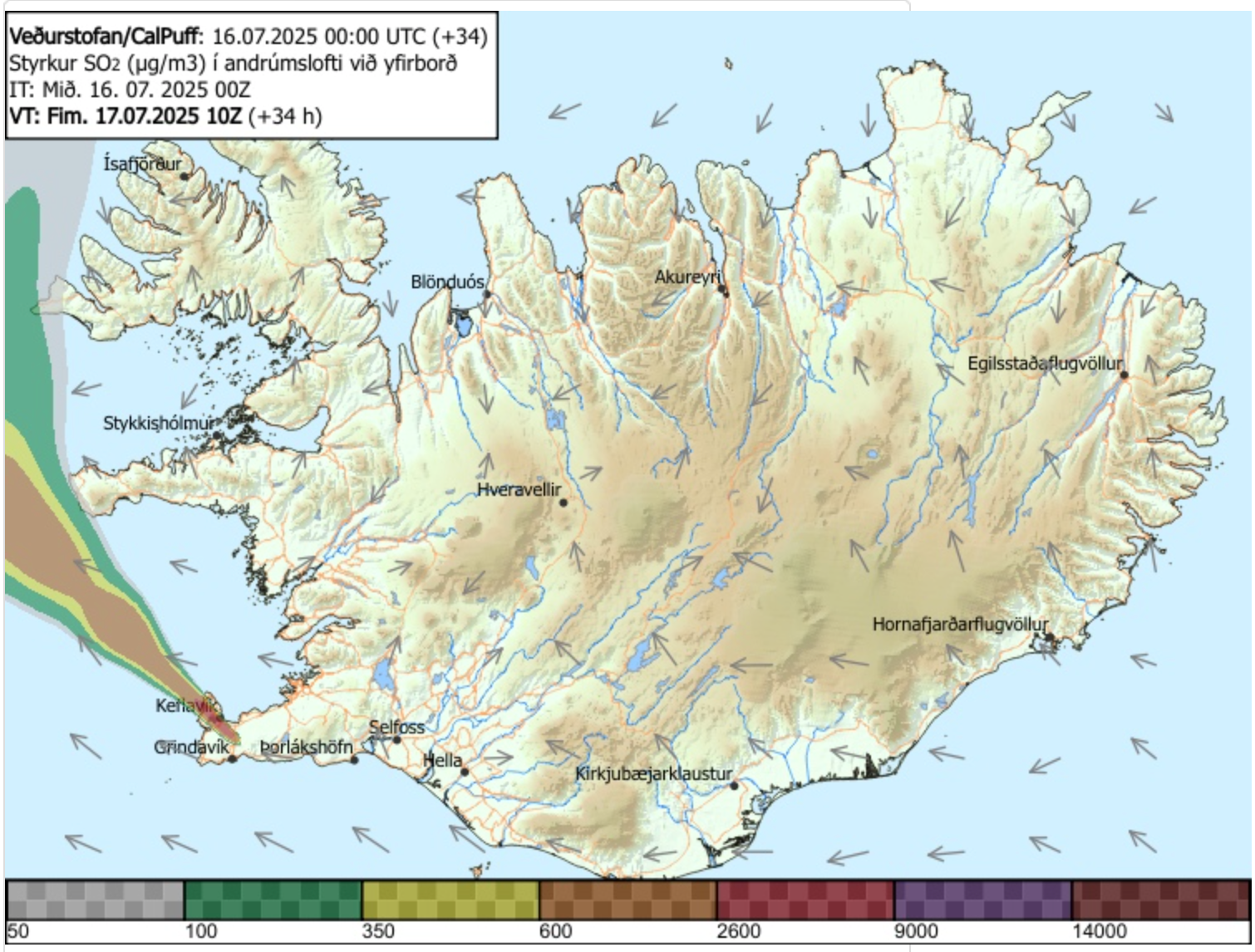
The IMO warned local residents to monitor air quality and move away from the area if they experience any symptoms from the gas cloud.
The most common symptoms from breathing in sulphur dioxide are irritation to the nose and throat, but exposure to high levels can cause nausea, vomiting, stomach pain and corrosive damage to the airways and lungs.
Full story: Iceland volcano erupts opening up 1km-long fissure
Wednesday 16 July 2025 13:30 , Stuti MishraA volcano on Iceland’s Reykjanes Peninsula erupted again on Wednesday, spewing lava and smoke in what officials say is the twelfth eruption in the region since 2021.
The eruption prompted fresh evacuations from the nearby town of Grindavík, a luxury hotel, and the popular Blue Lagoon spa, Icelandic authorities said.
The Icelandic Meteorological Office (IMO) said magma pushed through the earth’s crust, opening a fissure estimated to be between 700 and 1,000 metres long.
Read more:

Tourists evacuated as Iceland volcano erupts opening up 1km-long fissure
Evacuations ordered in Grindavík
Wednesday 16 July 2025 12:15 , Stuti MishraThe eruption prompted fresh evacuations from the nearby town of Grindavík. However, the town has been almost empty for months.
Authorities first ordered a full evacuation of the town in November 2023 after seismic activity and land deformation signalled a high risk of magma movement beneath the area.
A fissure eruption in December caused structural damage to roads and buildings. Subsequent eruptions in January and February 2024 led to further destruction, including the collapse of homes and the death of one person due to ground cracking.
Although some residents briefly returned during calmer periods, the area has remained largely off-limits.
Recent eruptions in Iceland
Wednesday 16 July 2025 11:45 , Stuti MishraToday’s eruption near Sundhnúkur crater is the 12th since volcanic activity reawakened on the Reykjanes Peninsula in 2021, ending nearly 800 years of geological silence in the region.Here’s a quick look at the most recent eruptions in the same system:
- Dec 2023: A powerful fissure eruption near Hagafell led to the first full evacuation of Grindavík and triggered widespread ground deformation.
- Jan 2024: Lava breached defences, destroying homes and killing one person in a ground collapse.
- Feb 2024: A short but intense eruption cut off hot-water pipelines, causing major disruption in the region.
- Mar–May 2024: The longest and most voluminous eruption so far, lasting 54 days and producing 35 million cubic metres of lava.
- May–June 2024: Another eruption followed, keeping the region under continuous alert.
- Nov–Dec 2024: Lava reached the Blue Lagoon car park during a fissure event, prompting mass evacuations once again.
What makes Iceland so volcanically active?
Wednesday 16 July 2025 11:15 , Stuti MishraIceland sits directly on the Mid-Atlantic Ridge, where the North American and Eurasian tectonic plates are pulling apart.
This geological hotspot fuels regular volcanic and seismic activity. The Reykjanes Peninsula, now erupting again, had been dormant for 800 years before reawakening in 2021.
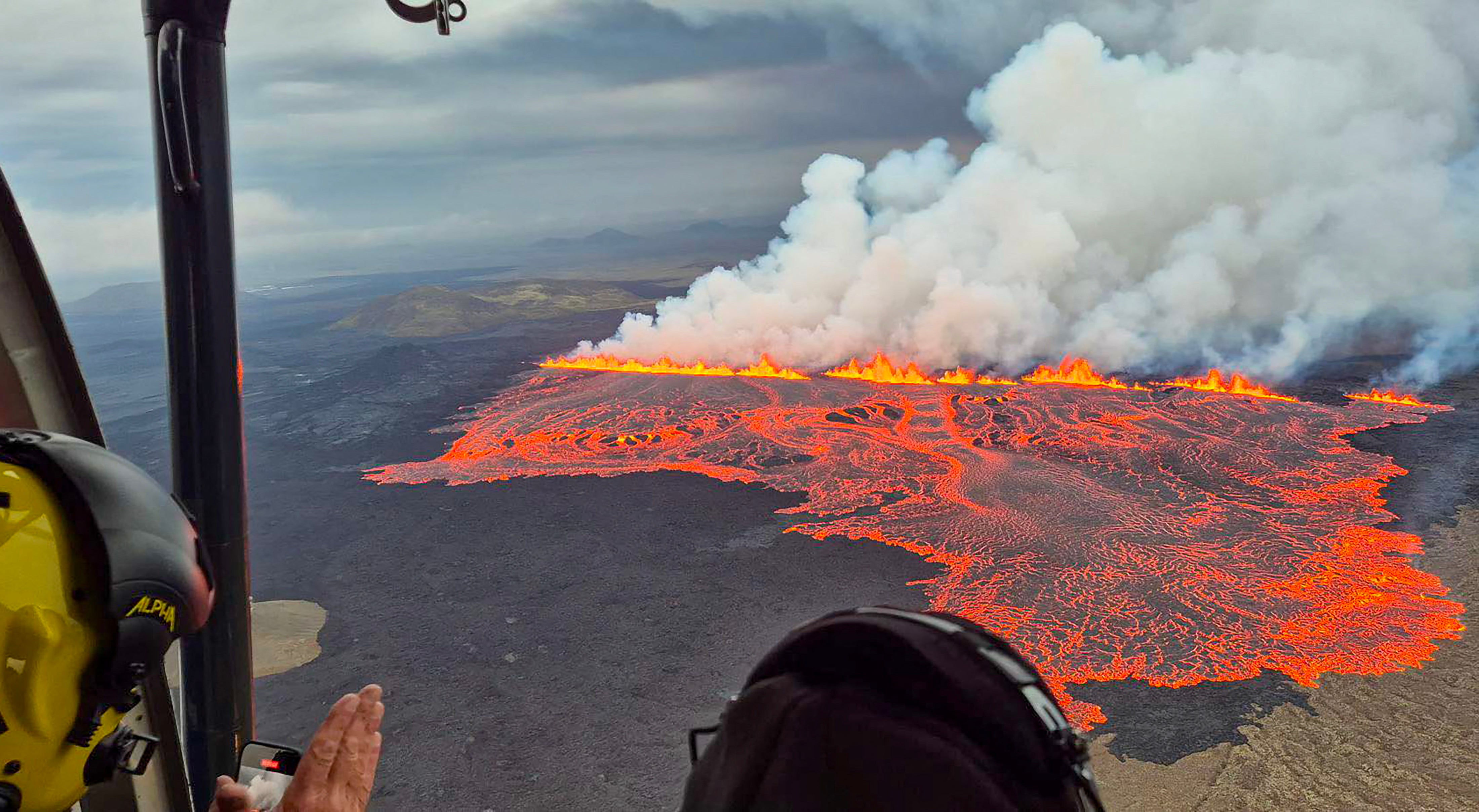
This is what we know so far about the Sundhnúkur eruption in Iceland
Wednesday 16 July 2025 10:30 , Stuti Mishra- A volcanic eruption began early on Wednesday near Sundhnúkur crater on the Reykjanes Peninsula, southwest Iceland.
- Lava is flowing from a fissure estimated to be 700–1,000 metres long, according to the Icelandic Meteorological Office (IMO).
- Authorities evacuated Grindavík, the nearby Blue Lagoon resort, and surrounding areas as a safety measure.
- No infrastructure has been damaged so far, and there is currently no threat to populated areas.
- The eruption has not affected flights at Keflavík International Airport, operations are continuing as normal.
- This marks the 12th eruption in the Reykjanes region since 2021, part of a prolonged volcanic cycle.
- Experts warn that similar eruptions may continue in the region over the coming months or years.
Current eruption is relatively small, officials say
Wednesday 16 July 2025 09:52 , Stuti MishraIceland’s latest volcanic eruption on the Reykjanes Peninsula is not considered a major event, according to the Icelandic Meteorological Office.
The fissure, located near Sundhnúkur crater, measures about 700 to 1,000 metres long, but officials say the eruption is relatively small, with lava flowing steadily to the southeast, away from critical infrastructure.
“There is no immediate threat to populated areas or key services,” the IMO said, adding that deformation data and GPS readings suggest limited magma output.
Civil defence authorities have evacuated surrounding areas as a precaution, but most of the disruption is localised.
Unlike explosive eruptions that produce large ash plumes, this is a low-ash fissure eruption, meaning it’s unlikely to affect air travel or trigger widespread fallout.
Similar eruptions have occurred on the peninsula repeatedly since 2021 as part of a longer volcanic cycle.

Air travel remains normal following Iceland volcano eruption
Wednesday 16 July 2025 09:42 , Stuti MishraFlights at Reykjavík’s Keflavík International Airport are unaffected following the volcano eruption.
Flight radar and airport communications show no cancellations or diversions, and airlines including Icelandair, easyJet, and PLAY are operating as scheduled. The eruption does not project ash into the stratosphere, so international routes remain clear, officials say.
Despite ongoing lava flows near Grindavík, experts say this eruption's low-ash nature means it’s unlike the previous disruptive events which have grounded flights.
Blue Lagoon evacuated as Sundhnúkur erupts
Wednesday 16 July 2025 09:41 , Stuti MishraIceland’s Blue Lagoon geothermal spa and nearby Grindavík were evacuated early today after Sundhnúkur volcano reactivated.
Civil defence teams have evacuated hotel guests, campers, and residents as a precaution, officials said.
The Blue Lagoon resort is one of the most luxurious and renowned hotels in the region, famous for its geothermal spa.
The eruption came from a 700–1,000 m fissure on the Reykjanes Peninsula.
Officials have described this as a small disruption as lava flows southeast, away from key infrastructure. However, this marks the 12th eruption in the region since 2021, part of a prolonged volcanic cycle that could last decades.

Iceland volcano erupts opening up 1km-long fissure
Wednesday 16 July 2025 09:06 , Stuti MishraA volcano on Iceland’s Reykjanes Peninsula erupted again on Wednesday, spewing lava and smoke in what officials say is the twelfth eruption in the region since 2021.
The eruption prompted fresh evacuations from the nearby town of Grindavík, a luxury hotel, and the popular Blue Lagoon spa, Icelandic authorities said.
The Icelandic Meteorological Office (IMO) said magma pushed through the earth’s crust, opening a fissure estimated to be between 700 and 1,000 metres long.
Read more:

Tourists evacuated as Iceland volcano erupts opening up 1km-long fissure
Gas cloud spreading north of volcano and projected to hit airport on Thursday
Wednesday 16 July 2025 16:00 , Alexander ButlerImagery from the Icelandic Meteorological Office shows a cloud of sulphur dioxide gas emanating from the volcano is currently being driven north towards the town of Keflavik.
The IMO forecasts that a slight change in wind conditions tomorrow will take the gas cloud directly over Iceland’s main international airport, which is located west of Keflavik.
The IMO warned local residents to monitor air quality and move away from the area if they experience any symptoms from the gas cloud.
The most common symptoms from breathing in sulphur dioxide are irritation to the nose and throat, but exposure to high levels can cause nausea, vomiting, stomach pain and corrosive damage to the airways and lungs.




